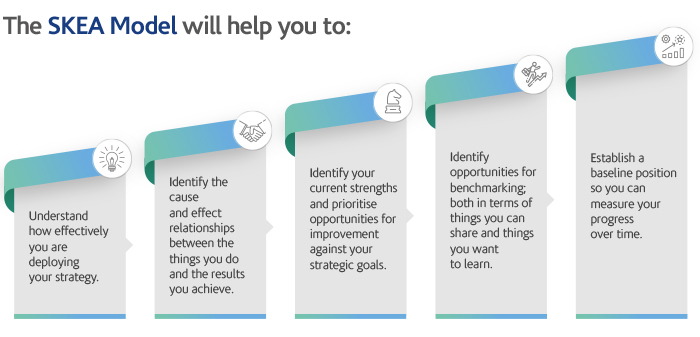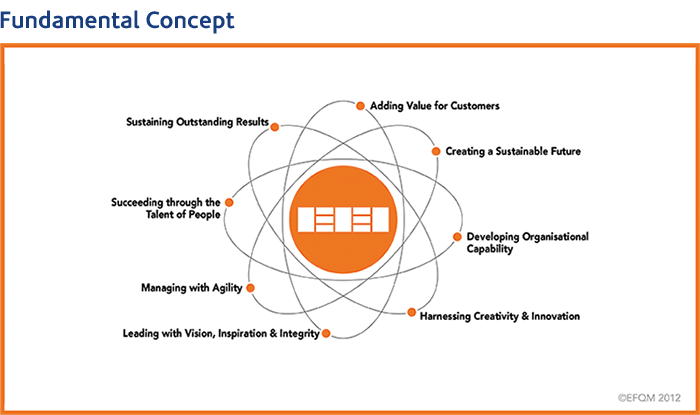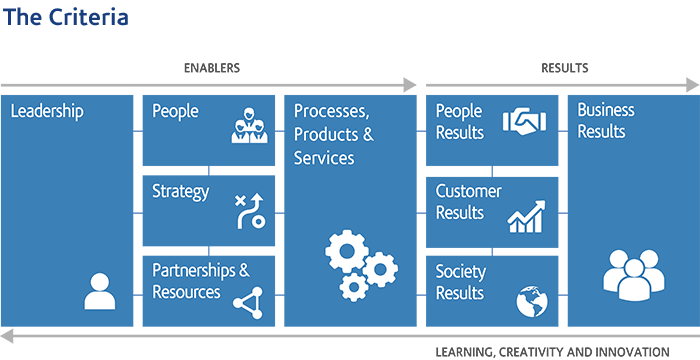 LEADERSHIP
LEADERSHIP
Excellent organisations have leaders who shape the future and make it happen, acting as role models for its values and ethics and inspiring trust at all times. They are flexible, enabling the organisation to anticipate and react in a timely manner to ensure the on-going success of the organisation.
- Leaders develop the mission, vision, values and ethics and act as role models.
- Leaders define, monitor, review and drive the improvement of the organisation’s management system and performance.
- Leaders engage with external stakeholders.
- Leaders reinforce a culture of excellence with the organisation’s people.
- Leaders ensure that the organisation is flexible and manages change effectively.
 STRATEGY
STRATEGY
Excellent organisations implement their Mission and Vision by developing a stakeholder focused strategy. Policies, plans, objectives and processes are developed and deployed to deliver the strategy.
- Strategy is based on understanding the needs and expectations of both stakeholders and the external environment.
- Strategy is based on understanding internal performance and capabilities.
- Strategy and supporting policies are developed, reviewed and updated.
- Strategy and supporting policies are communicated, implemented and monitored.
 PEOPLE
PEOPLE
Excellent organisations value their people and create a culture that allows the mutually beneficial achievement of organisational and personal goals. They develop the capabilities of their people and promote fairness and equality. They care for, communicate, reward and recognise, in a way that motivates people, builds commitment and enables them to use their skills and knowledge for the benefit of the organisation.
- People plans support the organisation’s strategy.
- People’s knowledge and capabilities are developed.
- People are aligned, involved and empowered.
- People communicate effectively throughout the organisation.
- People are rewarded, recognised and cared for.
 PARTNERSHIPS & RESOURCES
PARTNERSHIPS & RESOURCES
Excellent organisations plan and manage external partnerships, suppliers and internal resources in order to support their strategy, policies and the effective operation of processes. They ensure that they effectively manage their environmental and societal impact.
- Partners and suppliers are managed for sustainable benefit.
- Finances are managed to secure sustained success.
- Buildings, equipment, materials and natural resources are managed in a sustainable way.
- Technology is managed to support the delivery of strategy.
- Information and knowledge are managed to support effective decision making and to build the organisation’s capability.
 PROCESSES, PRODUCTS & SERVICES
PROCESSES, PRODUCTS & SERVICES
Excellent organisations design, manage and improve processes, products and services to generate increasing value for customers and other stakeholders.
- Processes are designed and managed to optimise stakeholder value.
- Products and services are developed to create optimum value for customers.
- Products and services are effectively promoted and marketed.
- Products and services are produced, delivered and managed.
- Customer relationships are managed and enhanced.
 CUSTOMER RESULTS
CUSTOMER RESULTS
Excellent organisations achieve and sustain outstanding results that meet or exceed the needs and expectations of their customers.
In practice, we find that excellent organisations:
- Use a set of perception measures and related performance indicators to determine the successful deployment of their strategy and supporting policies, based on the needs and expectations of their customers.
- Set clear targets for the key customer results based on the needs and expectations of their customers, in line with their chosen strategy.
- Segment results to understand the experience, needs and expectations of specific customer groups.
- Demonstrate positive or sustained good customer results over at least 3 years.
- Clearly understand the underlying reasons and drivers of observed trends and the impact these results will have on other performance indicators, perceptions and related outcomes.
- Have confidence in their future performance and results based on their understanding of the cause and effect relationships established.
- Understand how their key customer results compare to similar organisations and use this data, where relevant, for target setting.
Perceptions
These are the customers’ perceptions of the organisation. These may be obtained from a number of sources, including surveys, focus groups, ratings, compliments and complaints. These perceptions should give a clear understanding of the effectiveness, from the customers’ perspective, of the deployment and outcomes of the organisation’s customer strategy, supporting policies and processes.
MEASURES COULD INCLUDE PERCEPTIONS OF:
- Reputation and image
- Product and service value
- Product and service delivery
- Customer service, relationship and support
- Customer loyalty and engagement
Performance Indicators
These are the internal measures used by the organisation in order to monitor, understand, predict and improve the performance of the organisation and to predict their impact on the perceptions of its customers. These indicators should give a clear understanding of the deployment and impact of the organisation’s customer strategy, supporting policies and processes.
- Product and service delivery
- Customer service, relationships and support
- Complaints handling
- Involvement of customers and partners in the design of products, processes, etc.
 PEOPLE RESULTS
PEOPLE RESULTS
Excellent organisations achieve and sustain outstanding results that meet or exceed the needs and expectations of their people.
In practice, we find that excellent organisations:
- Use a set of perception measures and related performance indicators to determine the successful deployment of their strategy and supporting policies, based on the needs and expectations of their people.
- Set clear targets for key people results based on the needs and expectations of their people, in line with their chosen strategy.
- Segment results to understand the experience, needs and expectations of specific groups of people within their organisation.
- Demonstrate positive or sustained good people results over at least 3 years.
- Clearly understand the underlying reasons for and drivers of observed trends and the impact these results will have on other performance indicators and related outcomes.
- Have confidence in their future performance and results based on their understanding of the cause and effect relationships established.
- Understand how the key people results compare to similar organisations, and use this data, where relevant, for target setting.
Perceptions
These are the people’s perception of the organisation. These may be obtained from a number of sources, including surveys, focus groups, interviews and structured appraisals. These perceptions should give a clear understanding of the effectiveness, from the people’s perspective of the deployment and outcomes of the organisation’s people strategy and supporting policies and processes.
MEASURES COULD INCLUDE PERCEPTIONS OF:
- Satisfaction, involvement and engagement
- Motivation and empowerment
- Leadership and management
- Competency and performance management
- Training and career development
- Effective communications
- Working conditions
Performance Indicators
These are the internal measures used by the organisation in order to monitor, understand, predict and improve the performance of the organisation’s people and to predict their impact on perceptions. These indicators should give a clear understanding of the deployment and impact of the organisation’s people strategy and supporting policies and processes.
MEASURES COULD INCLUDE PERFORMANCE INDICATORS ON:
- Involvement and engagement activities
- Competency and performance management activities
- Leadership performance
- Training and career development activities
- Internal communications
 SOCIETY RESULTS
SOCIETY RESULTS
Excellent organisations achieve and sustain outstanding results that meet or exceed the needs and expectations of relevant stakeholders within society.
In practice, we find that excellent organisations:
- Use a set of perception measures and related performance indicators to determine the successful deployment of their strategy and supporting policies, based on the needs and expectations of the relevant external stakeholders.
- Set clear targets for key society results based on the needs and expectations of the relevant stakeholders within society, in line with their chosen strategy.
- Segment results to understand the experience, needs and expectations of relevant stakeholders within society.
- Demonstrate positive or sustained good society results over at least 3 years.
- Clearly understand the underlying reasons and drivers of observed trends and the impact these results will have on other performance indicators and related outcomes.
- Have confidence in their future performance and results based on their understanding of the cause and effect relationships established.
- Understand how their key society results compare to similar organisations and use this data, where relevant, for target setting.
Perceptions
This is society’s perception of the organisation. This may be obtained from a number of sources, including surveys, reports, press articles, public meetings, Non-Governmental Organisations, public representatives and governmental authorities. These perceptions should give a clear understanding of the effectiveness, from society’s perspective of the deployment and outcomes of the organisation’s societal and environmental strategy and supporting policies and processes.
MEASURES COULD INCLUDE PERCEPTIONS OF:
- Environmental impact
- Image and reputation
- Societal impact
- Workplace impact
- Awards and media coverage
Performance Indicators
These are the internal measures used by the organisation in order to monitor, understand, predict and improve the performance of the organisation and to predict their impact on the perceptions of the relevant stakeholder within society. These indicators should give a clear understanding of the deployment and impact of the organisation’s societal and environmental strategy and supporting policies and processes.
MEASURES COULD INCLUDE PERFORMANCE INDICATORS ON:
- Environmental, economic and societal activities
- Regulatory and governance compliance
- Health and safety performance
- Responsible sourcing and procurement performance
 BUSINESS RESULTS
BUSINESS RESULTS
Excellent organisations achieve and sustain outstanding results that meet or exceed the needs and expectations of their business stakeholders.
In practice, we find that excellent organisations:
- Develop a set of key financial and non-financial results to determine the successful deployment of their strategy, based on the needs and expectations of their business stakeholders.
- Set clear targets for key business results based on the needs and expectations of their business stakeholders, in line with their chosen strategy.
- Segment results to understand the performance of specific areas of the organisation and the experience, needs and expectations of business stakeholders.
- Demonstrate positive or sustained good business results over at least 3 years.
- Clearly understand the underlying reasons and drivers of observed trends and the impact these results will have on other performance indicators and related outcomes.
- Have confidence in their future performance and results based on their understanding of the cause and effect relationships established.
- Understand how their key business results compare to similar organisations and use this data, where relevant, for target setting.
Business Outcomes
These are the key financial and non-financial business outcomes which demonstrate the success of the organisation’s deployment of their strategy. The set of measures and relevant targets will be defined and agreed with the business stakeholders.
OUTCOME MEASURES COULD INCLUDE:
- Financial outcomes
- Business stakeholder perceptions
- Performance against budget
- Volume of key products or services delivered
- Key process outcomes
Business Performance Indicators
These are the key financial and non-financial business indicators that are used to measure the organisation’s operational performance. They help monitor, understand, predict and improve the organisation's likely business outcomes.
MEASURES COULD INCLUDE PERFORMANCE INDICATORS ON:
- Financial indicators
- Project costs
- Key process performance indicators
- Partner and supplier performance
- Technology, information and knowledge


